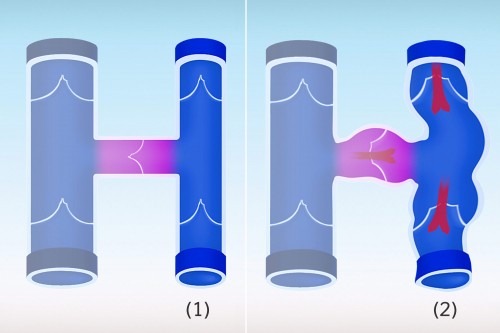About 30% of all women and men suffer from larger varicose veins
Here you find more information about the different types of varicose veins, their symptoms, and the complications

Development of varicose veins & underlying causes
When the veins give up
Multiple factors usually play a part in the development of varicose veins; our lifestyle also has an effect.
However, one thing that is certain is that varicose veins are usually due to a hereditary weakness of connective tissue or the vein wall and ultimately develop as a result of leaky valves in the superficial veins. It has not yet been worked out which comes first: whether the valves initially leak due to the connective tissue weakness or whether the vein walls first wear out and widen.
Whichever applies, the fact is that when the valves are no longer working properly, blood will flow in the wrong direction and collect in the legs. As a result of this, the veins gradually dilate over time and varicose veins develop.
All leg veins are equipped with valves at regular intervals. Together with the leg muscles and the pump function of the heart, these valves ensure that blood flows back to the heart against the force of gravity. Activating the leg muscles, for example by walking, compresses the deep veins lying between the muscles and forces the blood out of them. Healthy valves ensure that the blood flows in only one direction towards the heart and prevent any backflow to the feet. Most of the blood returns to the heart in the deep vein system. The superficial veins merely have a supporting role in blood transport, although they often cause problems and develop into varicose veins.
Animation: Development of varicose veins
When superficial veins enlarge because of hereditary connective tissue weakness, the valves do not expand at the same time. This disrupts valve function, as the valves are no longer big enough to close the dilated vein. As a result, there is a constant backflow to the feet that causes the vein to enlarge even further and varicose veins to develop.
Which patients are at risk of varicose veins?
Genetic predisposition is decisive as to whether our veins remain healthy for as long as possible or whether varicose veins develop. Besides the inherited connective tissue weakness, other factors may encourage varicose disease or make the condition worse.
Risk factors for the development of varicose veins
- Familial predisposition (hereditary)
- Advanced age
- Pregnancy
- Taking hormone products (e.g. the Pill)
- Sitting or standing for long periods
- Lack of exercise
- Overweight
- Smoking
Without doubt, the most important risk factors are a familial predisposition to varicose veins and age. It has been shown several times that the older people are, the more often they have varicose veins.
Worldwide, women seem to be somewhat more affected than men. The main reason for this difference can be found in the risk factor of pregnancy. The more often a woman is pregnant, the greater her chances of developing varicose veins. The hormonal changes and the physical load contribute to pregnant women developing varicose veins more easily. In contrast, the prevalence of varicose disease in childless women is similar to that in men.
Taking the Pill and hormone replacement therapy are usually regarded as risk factors, although the experts are not in total agreement about this.
Sitting or standing for long periods during work and insufficient exercise may also be risk factors. Although these factors are not the sole triggers of the disease, they may exacerbate the condition and its symptoms.
The experts are still not in agreement on overweight. Some studies have not shown any association between excess weight and varicose disease, while other studies suggest that there is a relationship. In particular, the symptoms seem to be worse in those who are overweight. Even when no varicose veins have developed, the flow rate of the blood through the veins is lower in overweight people than in those of a normal body weight. It is also certainly the case that seriously obese people move around less and pursue fewer sporting activities, which has additional negative effects on the blood flow and vein disease. All in all, the majority views overweight as a risk factor.
Taking recent studies into account, the question of whether smoking adversely affects varicose disease is also controversial. As smoking is anyway harmful to health, you should try to reduce the number of cigarettes you smoke or, even better, give up smoking at all.
Are you at risk of varicose veins? Click here to go to the vein check!

